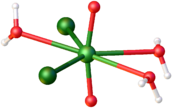Chemistry:Uranyl chloride
| File:UO2Cl2 formula solid state.tif | |
| Names | |
|---|---|
| IUPAC name
Dichlorodioxouranium
| |
| Other names
Uranium(VI), dichlorodioxy
| |
| Identifiers | |
3D model (JSmol)
|
|
| ChemSpider | |
| EC Number |
|
PubChem CID
|
|
| UNII | |
| |
| |
| Properties | |
| UO2Cl2 | |
| Molar mass | 340.90 |
| Melting point | Decomposes |
| Boiling point | Decomposes |
| Solubility in other solvents | 320 @ 18C |
| Hazards | |
| Safety data sheet | External MSDS |
Except where otherwise noted, data are given for materials in their standard state (at 25 °C [77 °F], 100 kPa). | |
| Infobox references | |
Uranyl chloride refers to inorganic compounds with the formula UO2Cl2(H2O)n where n = 0, 1, or 3. These are yellow-colored salts.
Synthesis and structures

The hydrates are obtained by dissolving uranyl sulfate or uranyl acetate in hydrochloric acid followed by crystallization from concentrated solutions. Depending on the method of drying, one obtains the mono- or the trihydrate. The monohydrate is described as a yellow, sulfur-like powder. It is very hygroscopic.[2] The trihydrate is greenish-yellow. Both hydrates are fluorescent solids that are highly soluble in water.[3]
The anhydrous material can be obtained by the reaction of oxygen with uranium tetrachloride:
- UCl4 + O2 → UO2Cl2 + Cl2
In terms of structures, all three of these compounds feature the uranyl center (trans-UO22+) bound to five additional ligands, which can include (bridging) chloride, water, or another uranyl oxygen.[4][5]
Reactions
The aquo ligands can be replaced by a variety of donors, e.g. THF.[6]
Industrial importance
The company Indian Rare Earths Limited (IREL) has developed a process to extract uranium from the Western and Eastern coastal dune sands of India . After pre-processing with high-intensity magnetic separators and fine grinding, the mineral sands (known as monazite), are digested with caustic soda at about 120 °C (248 °F) and water. The hydroxide concentrate is further digested with concentrated hydrochloric acid to solubilise all hydroxides to form a feed solution composed of chlorides of uranium and other rare earth elements including thorium. The solution is subjected to liquid–liquid extraction with dual solvent systems to produce uranyl chloride and thorium oxalate. The crude uranyl chloride solution is subsequently refined to nuclear grade ammonium diuranate by a purification process involving precipitation and solvent extraction in a nitrate media.
References
- ↑ Debets, P. C. (1968). "The structures of uranyl chloride and its hydrates". Acta Crystallographica Section B: Structural Crystallography and Crystal Chemistry 24 (3): 400–402. doi:10.1107/S056774086800244X.
- ↑ Hefley, Jack D.; Mathews, Daniel M.; Amis, Edward S. (1963). "Uranyl Chloride 1-Hydrate". Inorganic Syntheses. Inorganic Syntheses. 7. pp. 146–148. doi:10.1002/9780470132388.ch41. ISBN 9780470132388.
- ↑ F. Hein, S. Herzog (1963). "Uranyl Chloride". in G. Brauer. Handbook of Preparative Inorganic Chemistry, 2nd Ed.. 2. NY, NY: Academic Press. pp. 1439.
- ↑ Taylor, J. C.; Wilson, P. W. (1973). "The Structure of Anhydrous Uranyl Chloride by Powder Neutron Diffraction". Acta Crystallographica Section B: Structural Crystallography and Crystal Chemistry 29 (5): 1073–1076. doi:10.1107/S0567740873003882.
- ↑ Leary, Joseph A.; Suttle, John F. (1957). "Uranyl Chloride". Inorganic Syntheses. Inorganic Syntheses. 5. pp. 148–150. doi:10.1002/9780470132364.ch41. ISBN 9780470132364.
- ↑ Wilkerson, Marianne P.; Burns, Carol J.; Paine, Robert T.; Scott, Brian L. (1999). "Synthesis and Crystal Structure of UO2Cl2(THF)3: A Simple Preparation of an Anhydrous Uranyl Reagent". Inorganic Chemistry 38 (18): 4156–4158. doi:10.1021/ic990159g.
- "Uranium". Encyclopædia Britannica. V27. 1911. p. 788.
- Heyes, S.J. (1998). "Lanthanides & Actinides". Four Lectures in 2nd Year Inorganic Chemistry. http://www.chem.ox.ac.uk/icl/heyes/lanthact/lanthact.html.
External links
- Settle, Frank. "Nuclear Chemistry and the Community". www.chemcases.com: General Chemistry Case Studies. http://www.chemcases.com/nuclear/index.html.
 |

